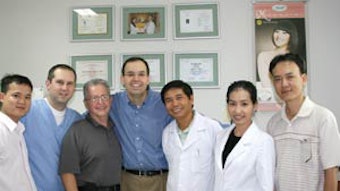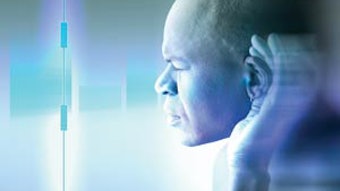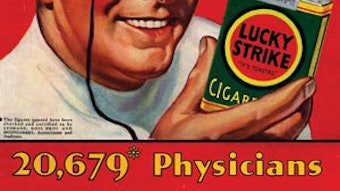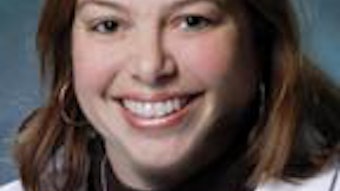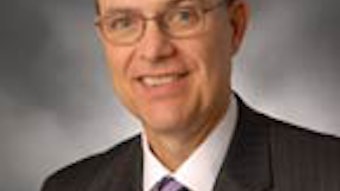ENT Medical Mission Trip to Riobamba, Ecuador
Karina T. Canadas, MD, Resident Travel Grantee, Yale-New Haven Hospital/Yale University School of Medicine Our first mission trip to Riobamba, Ecuador, with YHB charitable endowments and Clinica Dulce Refugio, was a great success. We were a 13-person team of ENT physicians, general surgeons, anesthesiologists, pediatricians, scrub techs, and nurses, led by Howard P. Boey, MD. Together, we provided ENT and general surgery care to the indigent population of the region at the Military Hospital of Riobamba, Ecuador, November 4-12, 2011. Nestled in the Andes Mountains between active volcanoes, Riobamba is a small city located 125 miles south of the capital of Quito. The area does not have surgical subspecialties, particularly ENT, readily available to its community. With an average household income of $160 per month, there are numerous barriers to accessing appropriate healthcare. In five days our group performed 58 surgeries on children and adults, 30 of which were ENT cases. Surgeries performed include thyroidectomies, cleft palate and nose repair, velopharyngeal insufficiency repair, septoplasties, tonsillectomies, adenoidectomies, and facial scar revisions. Our target population, in addition to the locals, included the indigenous population, the Shuar, who live nearby in the Amazon forest. Unfortunately, we could not help everyone. Such cases included three cleft lip and palate patients who weighed less than five kilos and were deemed too high an operative risk given the lack of appropriate local anesthesia equipment. One of these kids, a six-month-old with bilateral cleft lip and palate, I’ll never forget. He and his family were of the Shuar Indians and they traveled three hours, including two hours by foot, just to see us. Although the local foundation arranged for another medical mission trip to treat him in the near future, it was a frustrating feeling knowing you could not immediately help a patient, but it provided motivation to return after additional preparation. Overall, it was a wonderful experience. We had an immediate and lasting influence on the community, and everyone was incredibly thankful. Many even offered us the local delicacy of cooked guinea pig as a sign of gratitude. I tried to bring a little piece of this for the AAO-HNSF Humanitarian Efforts Committee and the Alcon Foundation as a sign of my gratitude for their support in funding me, but customs stopped me. I would definitely recommend this trip to anyone interested.
Karina T. Canadas, MD, Resident Travel Grantee, Yale-New Haven Hospital/Yale University School of Medicine
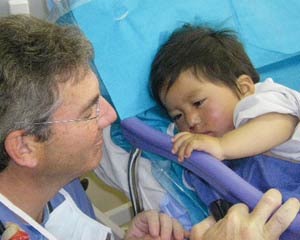 Brad Jubelirer, MD, with cleft palate patient in PACU.
Brad Jubelirer, MD, with cleft palate patient in PACU.Our first mission trip to Riobamba, Ecuador, with YHB charitable endowments and Clinica Dulce Refugio, was a great success. We were a 13-person team of ENT physicians, general surgeons, anesthesiologists, pediatricians, scrub techs, and nurses, led by Howard P. Boey, MD. Together, we provided ENT and general surgery care to the indigent population of the region at the Military Hospital of Riobamba, Ecuador, November 4-12, 2011.
Nestled in the Andes Mountains between active volcanoes, Riobamba is a small city located 125 miles south of the capital of Quito. The area does not have surgical subspecialties, particularly ENT, readily available to its community. With an average household income of $160 per month, there are numerous barriers to accessing appropriate healthcare.
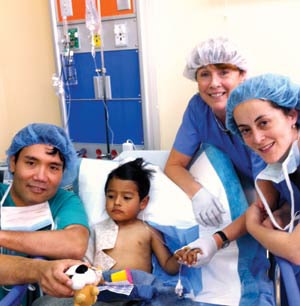 ENT and PACU team with post-op adenoidectomy patient: Howard Boey, MD (left)., Shauna Bartlett, Karina Canadas, MD (right).
ENT and PACU team with post-op adenoidectomy patient: Howard Boey, MD (left)., Shauna Bartlett, Karina Canadas, MD (right).In five days our group performed 58 surgeries on children and adults, 30 of which were ENT cases. Surgeries performed include thyroidectomies, cleft palate and nose repair, velopharyngeal insufficiency repair, septoplasties, tonsillectomies, adenoidectomies, and facial scar revisions. Our target population, in addition to the locals, included the indigenous population, the Shuar, who live nearby in the Amazon forest.
Unfortunately, we could not help everyone. Such cases included three cleft lip and palate patients who weighed less than five kilos and were deemed too high an operative risk given the lack of appropriate local anesthesia equipment. One of these kids, a six-month-old with bilateral cleft lip and palate, I’ll never forget. He and his family were of the Shuar Indians and they traveled three hours, including two hours by foot, just to see us. Although the local foundation arranged for another medical mission trip to treat him in the near future, it was a frustrating feeling knowing you could not immediately help a patient, but it provided motivation to return after additional preparation.
Overall, it was a wonderful experience. We had an immediate and lasting influence on the community, and everyone was incredibly thankful. Many even offered us the local delicacy of cooked guinea pig as a sign of gratitude. I tried to bring a little piece of this for the AAO-HNSF Humanitarian Efforts Committee and the Alcon Foundation as a sign of my gratitude for their support in funding me, but customs stopped me. I would definitely recommend this trip to anyone interested.
